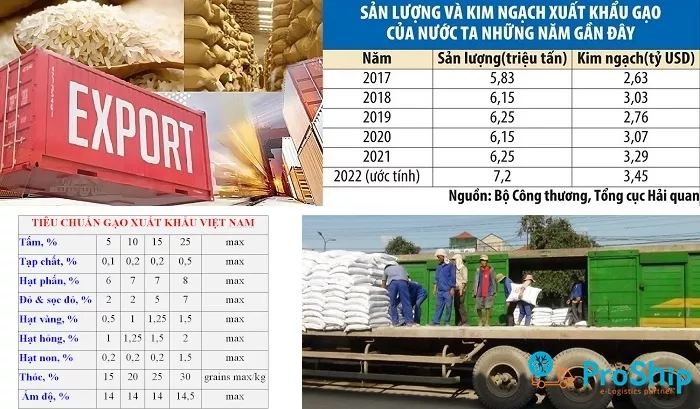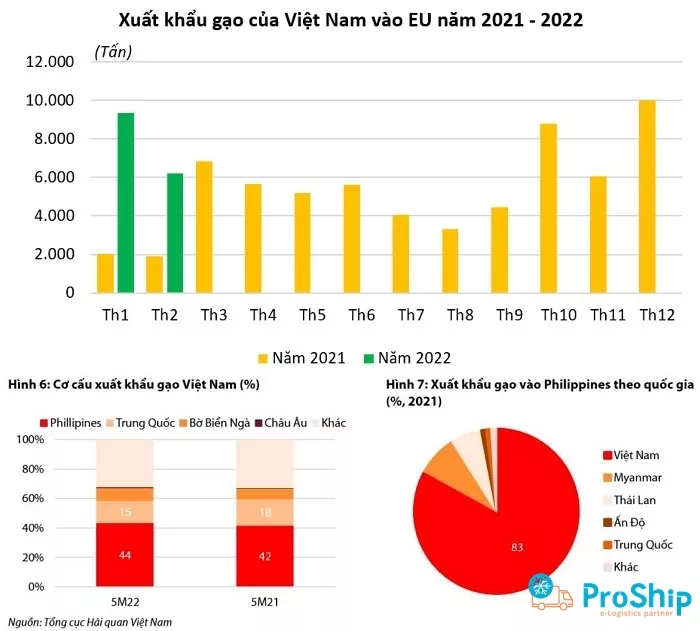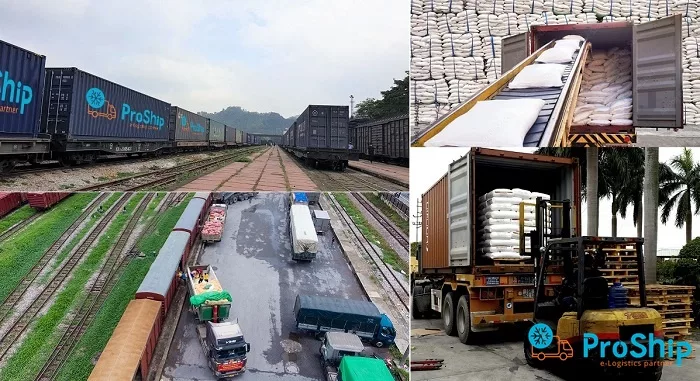x Các DN, chủ cơ sở kinh doanh gạo có nhu cầu đưa sản phẩm đi XK, giao thương tại Châu Âu, Châu Phi?
x Bạn muốn biết điều kiện – tiêu chuẩn xuất khẩu gạo sang Châu Âu, Châu Phi năm 2023 cụ thể là gì?
x Bạn muốn tìm một Nhà vận chuyển – XK gạo sang TQ, Châu Âu uy tín, hỗ trợ thủ tục hải quan từ A-Z?
Proship.vn sẽ cập nhật nhanh các Tiêu chuẩn xuất khẩu gạo sang Châu Âu và Châu Phi để Doanh nghiệp XNK có cơ sở hoàn thành mọi thủ tục hải quan, đáp ứng đủ điều kiện xuất khẩu cần thiết của 2 thị trường tiềm năng này. Qua đây, Proship Logistics cũng mong muốn đáp ứng tốt nhất mọi yêu cầu của Quý DN với việc cung cấp ra thị trường “Dịch vụ xuất khẩu gạo sang Châu Âu, Trung Quốc trọn gói giá rẻ”, đảm bảo thời gian thông quan nhanh, giao hàng kịp thời cho khách theo yêu cầu.
📦 Hotline Liên Hệ Vận Chuyển
🧭 Miền Trung
Tiêu chuẩn xuất khẩu Gạo sang Châu Âu, Châu Phi cập nhật mới nhất 2023
Lúa gạo là nguồn lương thực quan trọng và là mặt hàng xuất khẩu chiến lược của Việt Nam. Trung bình một năm, Việt Nam sản xuất khoảng 26 – 28 triệu tấn gạo, sau khi dành cho tiêu thụ trong nước, khối lượng gạo xuất khẩu khoảng 6 – 6,5 triệu tấn gạo/năm. Trong đó, vùng Đồng bằng sông Cửu Long – vựa lúa chính chiếm đến hơn 50% sản lượng và hơn 90% lượng gạo xuất khẩu của cả nước.
Xuất khẩu gạo đóng vai trò quan trọng đối với sự phát triển Kinh tế – Xã hội của Việt Nam. Những năm gần đây, Ngành gạo đã có những bước phát triển vượt bậc và đạt được nhiều kết quả khả quan. Hằng năm, lượng gạo của Việt Nam xuất khẩu chiếm khoảng 15% tổng lượng gạo xuất khẩu toàn thế giới. PROSHIP Logistics sẽ update nội dung mới nhất về Tiêu chuẩn xuất khẩu gạo sang Châu Âu (EU), Tiêu chuẩn xuất khẩu gạo sang Châu Phi (AU) năm 2023:
Tiêu chuẩn về chất lượng
Các loại gạo nhập khẩu phải tuân thủ các tiêu chuẩn thị trường chung. Chất lượng tiêu chuẩn của lúa gạo nhập khẩu theo luật pháp châu Âu phải đảm bảo các yếu tố về độ ẩm, sản lượng gạo xát, kích thước do EU đề ra. Quy định số 1308/2013, cập nhật năm 2020 của EC đưa ra tiêu chuẩn cho gạo, cụ thể:
- Có chất lượng cao, không mùi;
- Chứa độ ẩm tối đa 13%;
- Có sản lượng gạo xát nguyên hạt 63% trọng lượng (với tỷ lệ hạt lép 3%).
An toàn vệ sinh thực phẩm
Các quy định của EU về vệ sinh thực phẩm bao gồm tất cả các công đoạn sản xuất, chế biến, phân phối và đưa ra thị trường. EU quy định về an toàn vệ sinh thực phẩm như sau:
- Quy định EC số 178/2002: Luật thực phẩm chung châu Âu bao gồm các quy trình liên quan đến truy xuất nguồn gốc, các quy định liên quan đến vệ sinh và chất gây ô nhiễm trong thực phẩm;
- Quy định EC số 852/2004: Cập nhật năm 2021 về vệ sinh thực phẩm không có nguồn gốc động vật của Nghị viện và Hội đồng Châu Âu;
- Tuân thủ các hệ thống quản lý an toàn thực phẩm như ISO 9001, ISO 22000 cùng với việc áp dụng các nguyên tắc phân tích mối nguy và kiểm soát điểm tới hạn (HACCP) để đảm bảo an toàn sản phẩm.
ĐỌC THÊM: Dịch vụ vận chuyển Container nội địa
Kiểm soát chất gây ô nhiễm
Để tránh tác động đến chất lượng thực phẩm và sức khỏe con người, EU đặt ra giới hạn một số chất gây ô nhiễm có thể xuất hiện quá trình sản xuất, đóng gói, vận chuyển hoặc lưu giữ:
- Quy định EC số 1881/2006, cập nhật năm 2022 quy định về nồng độ tối đa các chất gây ô nhiễm nhất định trong thực phẩm để được phép xuất khẩu vào thị trường EU.
- Quy định EC số 315/93 cập nhật năm 2009 đặt ra các thủ tục cộng đồng về chất gây ô nhiễm trong thực phẩm.
Dư lượng thuốc bảo vệ thực vật
Năm 2017, EU đã thay đổi giới hạn dư lượng Tricyclazole trong gạo nhập khẩu vào EU giảm từ 1 mg/kg xuống 0,01 mg/kg:
- Quy định EC số 396/2005 cập nhật năm 2021 thiết lập mức dư lượng tối đa của thuốc bảo vệ thực vật trong các sản phẩm thực phẩm;
- Quy định EU số 540/2011, ngày 25/5/2011 xác định các hoạt chất được phép sử dụng và phạm vi sử dụng;
- Quy định EU số 2019/1793, ngày 22/10/2019 về gia tăng tạm thời các biện pháp kiểm soát chính thức và các biện pháp khẩn cấp trong việc quản lý hàng hóa NK từ nước thứ ba.
Ghi nhãn thực phẩm
Quy định EU số 1169/2011 được Ủy ban châu Âu quy định những quy tắc chung cho ghi nhãn áp dụng với tất cả các sản phẩm thực phẩm. Thông tin bắt buộc về tên sản phẩm, thành phần, khối lượng ròng, ngày hết hạn, điều kiện bảo quản, xuất xứ, hướng dẫn sử dụng, đánh dấu lô và bảng tuyên bố dinh dưỡng phải được cung cấp đầy đủ trên các thực phẩm trước khi đến tay người tiêu dùng.

Quy định về kiểm soát thực phẩm biến đổi gen (GMO)
Chỉ có một số giống biến đổi gen đã được cho phép, được sử dụng chủ yếu trong lĩnh vực thức ăn chăn nuôi. Đối với sản phẩm tiêu dùng, doanh nghiệp không bán thực phẩm biến đổi gen:
- Quy định EC số 1829/2003 xác định rằng không được đưa ra thị trường các sản phẩm chứa GMO nếu không được ủy quyền và tuân thủ các quy định về gắn nhãn.
- Quy định EU số 503/2013 cung cấp chương trình nộp đơn phê duyệt có hiệu lực trên toàn EU để các doanh nghiệp có thể đưa vào thị trường các sản phẩm biến đổi gen.
Quy định về truy xuất nguồn gốc và trách nhiệm của doanh nghiệp
Quy định EC số 178/2002 thiết lập các nguyên tắc chung về truy xuất nguồn gốc sản phẩm thông qua các giai đoạn sản xuất, chế biến và phân phối. Nó cũng xác định các trách nhiệm của các nhà sản xuất, các nhà nhập khẩu và các nhà phân phối trong việc đảm bảo an toàn thực phẩm:
Quy định kiểm dịch thực vật
EU đặt ra các quy định liên quan đến kiểm dịch thực vật và sản phẩm từ thực vật nhập khẩu, nhằm đảm bảo các cây trồng không bị nhiễm sâu bệnh hay các sinh vật khác gây hại. Các quy định về kiểm dịch thực vật được áp dụng tại thời điểm lô hàng nhập khẩu vào EU.
- Quy định số 2005/15/EC đối với vật liệu đóng gói và vật liệu lót bằng gỗ, yêu cầu vật liệu đóng gói hoặc sản phẩm thực vật làm từ gỗ không được chứa sâu bệnh;
- Đạo luật mới về Sức khỏe thực vật của EU số 2016/2031 quy định tất cả các sản phẩm thực vật sống bắt buộc phải có chứng nhận kiểm dịch thực vật và tuân thủ các quy định về dịch hại nghiêm ngặt;
- Quy định EU số 2019/2072 cung cấp chi tiết về thực hiện các biện pháp bảo vệ chống lại sâu bệnh.
ĐỌC THÊM: Dịch vụ vận chuyển Container Lạnh đường sắt giá rẻ
Thủ tục, quy trình xuất khẩu Gạo sang Châu Âu, Châu Phi như thế nào?
PROSHIP đã cập nhật tiêu chuẩn xuất khẩu gạo sang Châu Âu cũng như tiêu chuẩn xuất khẩu gạo sang Châu Phi mới nhất 2023. Tiếp theo đây sẽ là nội dung liên quan tới thủ tục, quy trình xuất khẩu nông sản gạo sang nước ngoài,…DN cần biết:
HS Code Gạo
Để xác định đúng về chính sách và thủ tục hải quan xuất khẩu gạo, trước tiên, bạn cần phải xác định rõ mã số HS của mặt hàng này. Gạo có HS thuộc Chương 10 ngũ cốc bao gồm:
| Mã HS mặt hàng | Mô tả |
| 1006 | Lúa gạo. |
| 100610 | – Thóc: |
| 10061010 | – – Để gieo trồng |
| 10061090 | – – Loại khác |
| 100620 | – Gạo lứt: |
| 10062010 | – – Gạo Hom Mali (SEN) |
| 10062090 | – – Loại khác |
| 100630 | – Gạo đã xát toàn bộ hoặc sơ bộ, đã hoặc chưa được đánh bóng hoặc hồ (glazed): |
| 10063030 | – – Gạo nếp (SEN) |
| 10063040 | – – Gạo Hom Mali (SEN) |
| – – Loại khác: | |
| 10063091 | – – – Gạo đồ (1) |
| 10063099 | – – – Loại khác |
Chính sách và hợp đồng xuất khẩu gạo
Theo Nghị định về tương lai xuất khẩu gạo, Doanh nghiệp phải có giấy chứng nhận đầy đủ điều kiện kinh doanh, xuất khẩu gạo của Bộ Công thương. Khi xuất khẩu mặt hàng gạo, Doanh nghiệp cần đăng ký Hợp đồng xuất khẩu gạo. Hồ sơ đăng ký hợp đồng xuất khẩu gạo bao gồm:
- Bản chính hoặc bản sao hợp lệ hợp đồng xuất khẩu gạo đã được ký kết của hai bên;
- Bản chính báo cáo lượng thóc, gạo có sẵn, trong đó có nêu rõ tổng lượng thóc, tổng lượng gạo có sẵn trong kho, địa chỉ cụ thể, số lượng thóc gạo trong mỗi kho của thương nhân;
- Bản sao hợp lệ giấy chứng nhận đủ điều kiện kinh doanh, xuất khẩu gạo còn hiệu lực khi đăng ký hợp đồng lần đầu;
- Trong trường hợp được ưu tiên theo quy định của chính phủ, thương nhân cần phải nộp thêm văn bản đề nghị ưu tiên và báo cáo tổng hợp việc mua thóc, gạo trực tiếp, thông qua hợp đồng tiêu thụ nông sản với người sản xuất kèm theo các chứng từ liên quan để chứng minh.
Quy trình thủ tục hải quan xuất khẩu gạo
Quy trình thủ tục hải quan xuất khẩu gạo khá rườm rà và nhiều khó khăn. Chính vì vậy, việc nắm rõ các quy trình và thủ tục xuất khẩu gạo sẽ giúp bạn có thêm nhiều tham khảo trong quá trình vận chuyển:
- Tờ khai hải quan: Bạn cần thực hiện việc khai báo trên tờ khai hải quan và nộp hai bản chính tờ khai xuất khẩu dựa vào mẫu HQ/2015/XK Phụ lục 4 ban hành kèm theo Thông tư 39 – 2018 TT-TBC;
- Hóa đơn thương mại giấy tờ có giá trị tương đương nếu người mua phải thanh toán cho người bán cần có một bản chụp;
- Giấy phép về xuất khẩu hàng hóa hoặc các văn bản cho phép doanh nghiệp được xuất khẩu do cơ quan có thẩm quyền quy định về quản lý ngoại thương đối với hàng hóa xuất khẩu thuộc diện quản lý theo giấy phép;
- Giấy thông báo không cần kiểm tra hoặc văn bản thông báo kết quả kiểm tra chứng từ khác theo quy định của pháp luật: 1 bản chính;
- Giấy tờ chứng minh doanh nghiệp đủ điều kiện để xuất khẩu hàng hóa: Một bản chụp khi làm thủ tục xuất khẩu hàng hóa lần đầu;
- Hợp đồng ủy thác: Một bản chụp doanh nghiệp ủy thác hàng hóa cần có giấy phép được xuất khẩu giấy chứng nhận kiểm tra chuyên ngành.
📦 Hotline Liên Hệ Vận Chuyển
🧭 Miền Trung
NÊN ĐỌC: Xuất khẩu Sầu riêng sang Trung Quốc
Tình hình tiêu thụ và XK Gạo Việt Nam sang Châu Âu, Châu Phi hiện nay
Tình hình xuất khẩu gạo Việt Nam sang Châu Âu
Việt Nam hiện đứng thứ 7 trong số các nước xuất khẩu gạo lớn nhất cho thị trường Châu Âu. Lượng gạo xuất khẩu từ Việt Nam các nước Châu Âu đạt 66,26 nghìn tấn, trị giá 42,8 triệu USD trong năm 2020, ghi nhận mức tăng trưởng bình quân 24,1%/năm giai đoạn 2015 – 2020. Mức tăng trưởng mạnh cho thấy, Gạo Việt Nam đang dần đáp ứng được điều kiện và và thị yếu tiêu dùng của thị trường EU.
Tuy nhiên, xuất khẩu gạo Việt Nam sang EU còn chiếm tỷ trọng rất nhỏ (1%) trong tổng kim ngạch xuất khẩu gạo của cả nước. Khối lượng và kim ngạch nhập khẩu gạo của EU từ Việt Nam cũng còn thấp so với các nước ASEAN khác như Thái Lan, Myanmar và Campuchia. Lý do cho tình trạng này là bởi thuế suất mà EU áp dụng lên gạo nhập khẩu từ Việt Nam khá cao khiến giá bán bị đẩy lên, giảm khả năng cạnh tranh với sản phẩm gạo từ các Nhà cung ứng lớn.
Bên cạnh đó, việc phải đáp ứng những quy định, tiêu chuẩn kỹ thuật đặc biệt nghiêm ngặt từ thị trường EU cũng khiến các DN Việt gặp nhiều khó khăn trong việc XK gạo sang thị trường này. Khả năng đáp ứng các tiêu chuẩn về chất lượng, vệ sinh an toàn thực phẩm của nông sản Việt Nam chưa cao, ngoài ra các lô hàng cũng chưa được đồng nhất, mẫu mã chưa đẹp.
Thế nhưng, Gạo Việt lại được hưởng lợi từ EVFTA. EVFTA đã giúp Gạo Việt cạnh tranh được với các nước, tạo cơ hội cho các DN Việt Nam tăng thị phần xuất khẩu gạo tại thị trường EU. Khi EVFTA có hiệu lực, EU dành cho Việt Nam ưu đãi thuế suất 0% với hạn ngạch 80.000 tấn gạo/năm (gồm 30.000 tấn gạo xay xát, 20.000 tấn gạo chưa xay xát và 30.000 tấn gạo thơm). Đối với mặt hàng gạo, EU sẽ giảm thuế suất về 0% sau 3 đến 5 năm. Với nhu cầu tiêu thụ gạo đặc sản từ Châu Á ngày càng tăng, chắc chắn trong tương lai thị trường EU tiếp tục là thị trường xuất khẩu gạo tiềm năng của các Doanh nghiệp Việt Nam.

Tình hình xuất khẩu gạo Việt Nam sang Châu Phi
Gạo tiếp tục là mặt hàng xuất khẩu số 1 của nước ta tại khu vực này, chiếm 30% tổng giá trị xuất khẩu của Việt Nam sang Châu Phi và chiếm 20% tổng kim ngạch xuất khẩu gạo của Việt Nam ra thế giới. Tuy nhiên, tại khu vực thị trường này, gạo Việt Nam cũng gặp phải không ít những khó khăn, thách thức.
Năm 2012, Việt Nam đã xuất khẩu gạo sang 30 trên tổng số 55 nước Châu Phi (giảm 2 thị trường so với năm 2011) với kim ngạch 763,3 triệu USD, tăng 2% so với năm trước đó. Gạo tiếp tục là mặt hàng xuất khẩu số 1 của nước ta tại khu vực này, chiếm 30% tổng giá trị xuất khẩu của VN sang Châu Phi và chiếm 20% tổng kim ngạch xuất khẩu gạo của VN ra thế giới.
Những thị trường nhập khẩu gạo nhiều nhất của Việt Nam ở châu Phi gồm có Bờ Biển Ngà (203,4 triệu USD), Ghana (149,6 triệu USD), Senegal (66 triệu USD), Angola (54,6 triệu USD), Cameroon (43,9 triệu USD), Algeria (35,6 triệu USD), Mozambique (32,5 triệu USD), Kenya (31,2 triệu USD), Tanzania (26 triệu USD), Guinea (22,8 triệu USD), Nam Phi (17,2 triệu USD), Nigeria (16,9 triệu USD), Liberia (11,4 triệu USD), Gabon (10,75 triệu USD),…
Tuy nhiên, khó khăn lớn nhất trong hoạt động xuất khẩu sang thị trường châu Phi chính là khâu thanh toán. Một trở ngại nữa là Doanh nghiệp hai bên thường thiếu thông tin về thị trường, đối tác của nhau. Do đó, để tránh rủi ro, các Doanh nghiệp Việt Nam thường xuất khẩu qua các Công ty trung gian Quốc tế. Điều này khiến giá gạo xuất khẩu Việt Nam bị đội lên, làm giảm tính cạnh tranh và đôi khi thương hiệu gạo Việt Nam không được người tiêu dùng địa phương biết đến.
>>Xem thêm: Danh mục hàng hóa xuất khẩu nhập khẩu
Proship Logistics có nhận xuất khẩu Gạo sang Trung Quốc, Châu Âu và hỗ trợ thủ tục hải quan, đóng thuế 2 đầu không?
Xuất khẩu gạo là một trong những ngành nghề Việt Nam ưu tiên hàng đầu. Thực tế, các đơn vị cung cấp Dịch vụ vận chuyển Gạo bằng đường sắt Quốc tế Á – Âu xuất hiện ngày càng nhiều nhưng không phải đơn vị nào cũng uy tín, có độ tin cậy cao. Tuy nhiên khi chọn CÔNG TY CỔ PHẦN PROSHIP và sử dụng Dịch vụ vận chuyển, xuất khẩu gạo bằng container đường sắt liên vận Quốc tế, quý DN được hưởng lợi rất nhiều về dịch vụ, bao gồm cả việc được hỗ trợ về khâu thủ tục thông quan, đóng thuế 2 đầu ga đi/ga đến.
Hiện chúng tôi đang thực hiện Chuyên tuyến container hàng nông sản từ Việt Nam – Trung Quốc – Mông Cổ – Kazakhstan – Nga – Châu Âu. Nhằm nâng cao năng lực vận tải, PROSHIP Logistics cũng đầu tư xây dựng bãi container, xe ô tô đầu kéo, thiết bị nâng hạ đủ khả năng vận hành container các loại như Cont 20 feet, Cont 40 feet, Cont 45 feet (khô/lạnh).
Với các tiêu chuẩn xuất khẩu gạo sang Châu Âu cũng như tiêu chuẩn xuất khẩu gạo sang Trung Quốc, phía chúng tôi đều nắm rõ để đảm bảo lô hàng nông sản Gạo của DN Việt Nam được tiếp cận nhanh hơn, gần hơn và hoàn toàn hợp lệ tại thị trường các nước. Tại Việt Nam, Proship bố trí kho tại Ga Trảng Bom, Ga Kép, Ga Sóng Thần, Ga Đông Anh, Ga Đà Nẵng,…còn tại nội địa Trung sẽ có kho ở Ga Bằng Tường (Trung Quốc) rất thuận lợi cho việc lưu trữ, bảo quản hàng nông sản của quý khách. Cam kết các sản phẩm Gạo đều đạt chuẩn và đủ điều kiện xuất khẩu đi các quốc gia, khu vực.

Các loại gạo Proship nhận xuất khẩu sang Trung Quốc và Châu Âu
Proship Logistics nhận xuất khẩu số lượng lớn các loại Gạo sau:
- XK Gạo Jasmine 85;
- XK Gạo Japonica;
- XK Gạo ST25;
- XK Gạo nếp;
- XK Gạo thơm Hương Lài,…
Lịch trình vận chuyển container đường sắt liên vận Quốc tế Á – Âu
Thông tin lịch tàu hàng chạy Liên vận Quốc tế 2023
* Việt Nam – Trung Quốc: Khởi hành hằng ngày
- Tuyến Yên Viên – Đồng Đăng – Pingxiang – Nanning Nan sau đó tiếp chuyển đi các tỉnh, thành phố của Trung Quốc (và ngược lại);
- Thời gian: 3 ngày (không bao gồm thời gian làm thủ tục tại các ga biên giới.
* Việt Nam – Trung Á: Khởi hành Chủ nhật hàng tuần
- Tuyến Yên Viên – Đồng Đăng – Pingxiang – Alashankou – Dostyk – Almaty/Astana – sau đó tiếp chuyển đi Uzbekistan, Tajikistan, Kyzgyzstan;
- Thời gian: 18 ngày (không bao gồm thời gian làm thủ tục tại các ga biên giới).
* Việt Nam – Nga: Khởi hành thứ 4 và Chủ nhật hàng tuần
- Tuyến Yên Viên – Đồng Đăng – Pingxiang – Manzhouli – Zabaykalsk – Vorsino (Moscow);
- Thời gian: 23 ngày (không bao gồm thời gian làm thủ tục tại các ga biên giới).
* Việt Nam – EU: Khởi hành thứ 4 và Chủ nhật hàng tuần
- Tuyến Việt Nam – Trung Quốc – Kazakhstan – Russia – Belarus – Poland (Malaszewicze) – Germany (Duisburg/Hamburg);
- Thời gian: 28 – 30 ngày (không bao gồm thời gian làm thủ tục tại các ga biên giới).
Thông tin lịch tàu chạy từ Trung tâm liên vận Quốc tế Ga Kép
- Vận chuyển hàng hóa Liên vận Quốc tế trên tuyến Kép – Đồng Đăng – Bằng Tường – Nam Ninh và ngược lại: Mỗi ngày 2 chuyến hàng;
- Vận chuyển hàng hóa nội địa trên tuyến Kép – Yên Viên – Đà Nẵng – Sóng Thần và ngược lại: Mỗi ngày 1 chuyến hàng;
- Dịch vụ vận chuyển hàng hóa khép kín Kho – Kho.
Phương thức vận chuyển – giao nhận hàng nông sản của Proship
Cách thức vận chuyển – giao hàng (Gạo) xuất khẩu tuyến Á – Âu của Proship:
- Vận chuyển gạo nguyên container từ Ga tới Ga;
- Vận chuyển gạo nguyên chuyến từ Ga tới Kho;
- Vận chuyển nông sản gạo bằng container từ Kho tới Kho;
- Các dịch vụ đi kèm khác nếu khách hàng yêu cầu.
Ưu thế Dịch vụ vận tải, XK hàng nông sản bằng đường sắt liên vận Quốc tế
Dịch vụ vận tải hàng liên vận Quốc tế Proship có các ưu thế nổi bật phải kể đến như:
- Giá cước Dịch vụ vận chuyển container đường sắt Á – Âu ổn định và cạnh tranh;
- Cơ sở hạ tầng đường sắt, phương tiện nâng/dỡ hàng hiện đại, chuyên biệt;
- Thủ tục hải quan thuận tiện, khai báo một lần từ điểm xuất phát đến điểm kết thúc;
- Vận chuyển khối lượng lớn và đa dạng hàng hóa (hàng công nghiệp, hàng nông sản, hàng tiêu dùng);
- Kho bãi tại 2 đầu ga đi/ga đến ở Ga Sóng Thần, Ga Trảng Bom, Ga Đông Anh, Ga Yên Viên, Ga Kép, Ga Đồng Đăng, Ga Bằng Tường,…;
- Thời gian vận chuyển nhanh chóng, an toàn, lịch chạy tàu hàng đường sắt cố định;
- Theo dõi lịch trình hàng hóa online trên toàn tuyến vận chuyển;
- Khả năng kết nối với các điểm đến nằm sâu trong nội địa xa hệ thống cảng biển;
- Chính sách bồi hoàn giá trị hàng XK thỏa đáng cho khách (nếu lỗi do vận chuyển).
Những nội dung liên quan tới tiêu chuẩn xuất khẩu gạo sang Châu Âu và tiêu chuẩn xuất khẩu gạo sang Châu Phi mới nhất 2023 đã được PROSHIP Logistics cập nhật chi tiết cho Quý DN đang có kế hoạch giao thương mặt hàng nông sản này tiện tham khảo nhằm hỗ trợ hiệu quả cho công việc thông quan lô hàng gạo.
Nhu cầu vận chuyển gạo Việt Nam – Châu Âu, Châu Phi, Châu Á ngày càng nhiều. Do đó, để được đảm bảo tốt nhất về chất lượng, tính an toàn, thời gian chuẩn xác cũng như giá cả DV hợp lý. Quý khách hàng vui lòng liên hệ 0909 344 247 để nhận tư vấn trực tiếp về Dịch vụ vận chuyển container gạo bằng đường sắt liên vận Quốc tế Á – Âu trọn gói giá rẻ.
📦 Hotline Liên Hệ Vận Chuyển
🧭 Miền Trung

